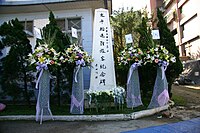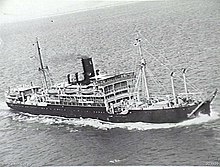Taiping (steamer)
You can help expand this article with text translated from the corresponding article in Chinese. (December 2015) Click [show] for important translation instructions.
|

Taiping was a Chinese steamer that sank after a collision with a smaller cargo ship, Chienyuan, while en route from mainland China to Taiwan on 27 January 1949. With an estimated death toll of over 1,500 people, it ranks as one of the ten deadliest maritime disasters in history.
Final voyage
Taiping was packed to nearly twice her rated capacity, carrying over 1,000 refugees fleeing advancing Chinese Communist forces during the Chinese Civil War, when she departed Shanghai, China on 26 January 1949, bound for Keelung, Taiwan.[1] Some estimates put the number of passengers on board at over 1,500,[2] although the ship was only rated to carry 580 passengers.[1]
After midnight on 27 January 1949, Taiping was steaming at night with her lights out, owing to a
Commemoration

Taiping, which made many journeys between mainland China and Taiwan before her tragic end, has been compared to the
In popular culture
The Crossing, a 2014 film directed by John Woo, is about the sinking of Taiping.[4]
References
- ^ a b Letu, Xinji. 8 July 2011. "The Sinking of the Chinese Titanic" Beijing Today. p. 14.
- ^ a b Iok-sin, Loa (28 January 2008). "Taiping sinking recalled". Taipei Times. Retrieved 20 May 2012.
- ^ a b Hsu, Jenny W. (18 January 2009). "Descendants of victims mark Taiping tragedy". Taipei Times. Retrieved 20 May 2012.
- ^ a b Lee, Maggie (4 December 2014). "Film Review: The Crossing: Part 1". Variety. Retrieved 26 January 2015.
